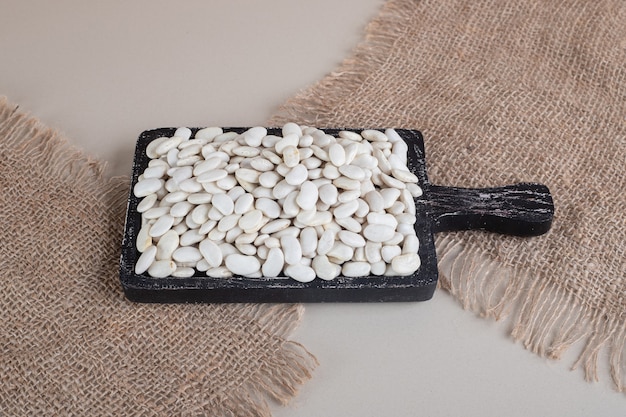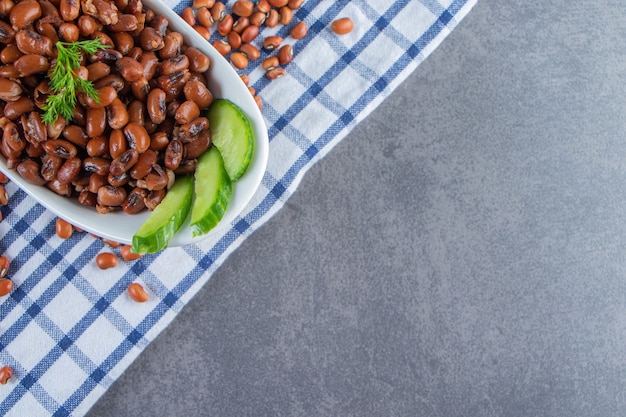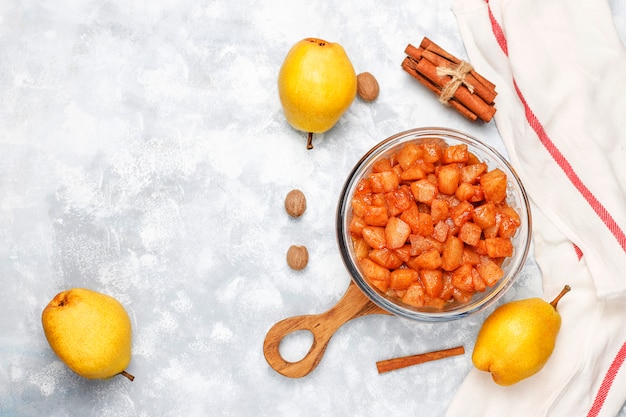As a seasoned cook, I've always held a special place in my heart for dried beans. They're a true pantry staple, offering a symphony of flavours and textures that can elevate any meal. But, let's be honest, dried beans can sometimes seem intimidating, especially for those new to the world of bean cookery. The thought of soaking them overnight and then simmering them for hours might feel like a culinary mountain to climb. But trust me, the effort is absolutely worth it, and I'm here to guide you through the process, from soaking to savouring, making it as easy as a gentle stroll through a culinary garden.
Today, we're going to delve into the world of dried lima beans, those delightful, creamy white beans that possess a unique, slightly sweet flavour. They're the perfect ingredient for everything from hearty stews and vibrant salads to creamy dips and even unexpected desserts. I'll share my tried-and-true methods for preparing them, along with some mouthwatering recipe ideas that will transform you into a dedicated dried lima bean enthusiast in no time.
(Part 1) The Soaking Process: A Foundation for Success

Soaking dried beans is a crucial first step that sets the stage for culinary success. It not only shortens the cooking time, making meal prep a breeze, but also improves their digestibility, reducing the risk of those pesky gas and bloating issues. I know, I know, it might seem like an extra step, but trust me, it's a small investment that yields a big payoff.
1.1 Choosing the Right Beans: Quality Matters
Start by choosing top-notch dried lima beans, the foundation of your culinary masterpiece. Look for beans that are firm, plump, and free from any blemishes or discoloration. I personally prefer buying my beans in bulk from a reputable store, as it often provides the best value for money. When storing them, ensure they're kept in an airtight container in a cool, dry place. This helps prevent them from absorbing moisture and becoming stale, ensuring they remain fresh and flavourful until you're ready to use them.
1.2 The Soaking Ritual: A Simple Yet Crucial Step
Once you've got your beans, it's time for the soaking ritual, a simple yet crucial step. The standard ratio is 1 cup of dried beans to 3 cups of water. Simply place the beans in a large bowl or container, cover them with cold water, and let them soak for at least 8 hours, or preferably overnight. I find that adding a pinch of salt to the soaking water helps reduce the bitterness of the beans, but it's entirely up to personal preference. The salt helps to draw out some of the natural bitterness, leaving you with a more pleasant flavour.
1.3 The Drain and Rinse: A Clean Start
After the soaking time is up, drain the beans thoroughly. I use a fine-mesh sieve for this purpose, ensuring that every last bit of water is removed. Rinse the beans under cold water until the water runs clear. This vital step removes any impurities or debris that might have settled in the soaking water, giving you a clean and fresh start for your culinary adventure.
(Part 2) Mastering the Art of Cooking: Transforming Beans into Deliciousness

Now that your beans are prepped and ready to go, it's time to transform them into a culinary masterpiece. Cooking dried beans is a simple process, but there are a few key techniques that ensure a smooth and flavorful experience.
2.1 The Pot's Ready, Let's Cook: The Essence of Even Cooking
Grab a large pot, one that's big enough to accommodate your beans with room to spare. Add the drained and rinsed beans along with fresh water. You'll want to use enough water to cover the beans by at least 2 inches, ensuring even cooking and preventing them from sticking to the bottom of the pot. Bring the pot to a boil over high heat, then reduce the heat to a gentle simmer. The simmering process is the heart of cooking dried beans, allowing them to cook evenly and develop their rich flavour. I recommend using a lid to help trap the steam and keep the beans moist. This creates a steamy environment that helps soften the beans and intensify their flavour.
2.2 Cooking Time: A Guide to Tender Perfection
The cooking time for dried lima beans can vary depending on the age of the beans and the altitude you're cooking at. But, a general guideline is to simmer the beans for about 1 hour, or until they are tender but still hold their shape. You can test their doneness by gently pressing a bean with the back of a spoon. If it easily mashes, it's ready. If it's still firm, simmer for a bit longer. It's better to err on the side of overcooked beans rather than undercooked ones, as overcooked beans are still perfectly edible, while undercooked beans can be quite tough.
2.3 Seasoning Your Beans: Adding a Touch of Magic
Now, it's time to add a touch of culinary magic! For simple seasoning, a pinch of salt and pepper will do the trick. But feel free to experiment with other herbs and spices. I love adding a bay leaf, thyme, or a sprig of rosemary for a fragrant touch. Garlic and onion are also excellent additions. Remember, the beauty of cooking with dried beans is their ability to absorb the flavours of whatever you add. So, get creative and have fun! Experiment with different combinations to find your perfect flavour profile.
(Part 3) Beyond the Basics: Delicious Lima Bean Dishes

Once your lima beans are cooked to perfection, the culinary possibilities are endless. They transform into a blank canvas for your culinary creativity, ready to be incorporated into a symphony of delicious dishes. Here are just a few ideas to get your taste buds tingling and your creative juices flowing.
3.1 A Hearty and Soul-Satisfying Stew: A Culinary Hug in a Bowl
I adore creating a hearty lima bean stew with chunks of smoked sausage, diced tomatoes, and a medley of aromatic vegetables. I love to simmer this stew for hours, allowing the flavours to meld beautifully and the beans to become utterly tender. It's the perfect comfort food on a chilly evening, a culinary hug in a bowl that warms you from the inside out. And, it's also fantastic for freezing and enjoying later, allowing you to savor the flavours on another day.
3.2 A Refreshing Salad with a Zing: A Summertime Delight
Lima beans add a wonderful creamy texture and a touch of sweetness to salads, transforming them into a delightful summertime treat. I often use them in a combination with other fresh ingredients like corn, black beans, avocado, and cilantro. Toss the salad with a light vinaigrette made with lime juice, olive oil, and a pinch of cumin. It's a healthy and satisfying dish that's perfect for a warm summer day, offering a refreshing and flavorful experience.
3.3 A Creamy and Flavorful Dip: A Crowd-Pleaser
Did you know lima beans can be the star ingredient in a delicious dip? Simply blend cooked lima beans with tahini, lemon juice, garlic, and a touch of salt and pepper. The result is a smooth and creamy dip that's perfect for spreading on crackers or dipping fresh vegetables. I often serve this dip with a sprinkle of paprika or a drizzle of olive oil for a touch of extra flavour. It's a crowd-pleaser that's sure to impress your guests.
3.4 A Sweet and Unexpected Treat: A Culinary Surprise
Lima beans can even be used in desserts! This might sound unusual, but trust me, it works! I've made a delicious and surprisingly addictive lima bean fudge by blending cooked beans with cocoa powder, butter, and maple syrup. The creamy texture and subtly sweet flavour are a delightful surprise. It's a great option for those who are looking for a healthier dessert alternative, a sweet treat that's both delicious and good for you.
(Part 4) FAQs: Your Lima Bean Questions Answered
I know that exploring the world of dried lima beans can raise a few questions. Let's address some common ones that often pop up in the minds of curious cooks.
4.1 Can I use canned lima beans instead of dried?
Yes, you can certainly use canned lima beans as a shortcut, saving you time and effort. They're already cooked and ready to go, making them a convenient option for a quick meal. However, they won't have the same depth of flavour as cooked-from-scratch beans. If you're looking for the most authentic and flavorful experience, I recommend starting with dried beans. They offer a more intense flavour and a rewarding culinary experience.
4.2 How long can I store cooked lima beans?
Once your beans are cooked, they can be stored in the refrigerator for up to 4 days. Make sure to store them in an airtight container to prevent them from drying out and losing their moisture, preserving their flavour and texture. You can also freeze cooked beans for up to 3 months. To freeze, spread the beans in a single layer on a baking sheet until frozen solid. Then transfer them to a freezer-safe bag or container. This helps prevent them from clumping together, making them easy to use later on.
4.3 What if my beans are too hard after cooking?
If your beans are still firm after the recommended cooking time, don't worry! It's likely that they just need a bit more time to reach perfect tenderness. Add a little more water, cover the pot, and continue to simmer until they reach your desired consistency. It's best to err on the side of overcooked beans rather than undercooked ones. Overcooked beans are still perfectly edible, while undercooked beans can be quite tough and unpleasant to eat.
4.4 Are there any nutritional benefits to eating lima beans?
Absolutely! Lima beans are a fantastic source of protein, fiber, and essential vitamins and minerals. They're also low in fat and calories, making them a healthy and filling choice. So, indulge in those creamy, delicious beans knowing that you're doing something good for your body. They're a nutritional powerhouse that adds flavour and goodness to your meals.
4.5 What are some tips for making the best lima bean dishes?
Here are a few tips to help you master the art of lima bean cooking and create delicious dishes:
- Don't over-salt your beans during the cooking process. You can always add more salt later to taste, allowing you to fine-tune the flavour to your preference.
- Add acidic ingredients like tomatoes or vinegar towards the end of cooking to prevent the beans from becoming tough. The acidity helps to soften the beans and enhance their flavour.
- If you're making a stew or soup, consider adding a spoonful of cornstarch or flour to thicken the sauce. This will help create a richer, more satisfying texture, adding a velvety richness to your dishes.
- Get creative with your seasonings and add-ins. Experiment with different herbs, spices, vegetables, and meats to discover your own favourite combinations. The culinary world is your oyster, so explore and discover new flavour combinations.
- Don't be afraid to try new recipes. The internet is a treasure trove of lima bean inspiration, offering a wealth of culinary adventures to embark on.
(Part 5) From Humble Bean to Culinary Star: The Transformation of Lima Beans
As you've seen, dried lima beans are truly a versatile ingredient, capable of transforming from humble pantry staple to culinary star. From simple, comforting stews to vibrant salads and even surprising desserts, their possibilities are endless. It's a joy to discover new ways to use them, and I encourage you to embrace their culinary potential. Let your imagination run wild, and you'll be amazed by the delicious possibilities that await you.
Remember, the key to success lies in mastering the basics: soaking, cooking, and seasoning. Once you've got those down, the rest is just creative exploration. So, go forth, cook with confidence, and enjoy the deliciousness that dried lima beans have to offer! Embrace the culinary journey, and you'll be rewarded with a symphony of flavours and textures.
(Part 6) A Taste of Lima Bean History: A Journey Through Time
Dried lima beans have a rich and fascinating history, dating back centuries. They're believed to have originated in the Andean region of South America, where they were cultivated by indigenous peoples. Lima beans were a staple food for these civilizations, and their importance was deeply ingrained in their culture and traditions. Their significance transcended mere sustenance, becoming a symbol of their way of life and their connection to the land.
The name "lima bean" is thought to have come from the city of Lima, Peru, where they were widely cultivated and appreciated for their unique flavour and texture. The beans were reportedly introduced to Europe by Spanish explorers in the 16th century, and they quickly became popular throughout the continent, spreading their culinary charm far and wide. Today, lima beans are enjoyed worldwide and are a cherished ingredient in many cuisines, a testament to their enduring appeal and adaptability.
(Part 7) Exploring Regional Variations: A Culinary World Tour
Just like many other foods, lima beans have evolved into a variety of regional variations, reflecting the culinary traditions and preferences of different cultures. From the hearty stews of the Southern United States to the vibrant salads of the Mediterranean, there's a world of lima bean recipes to discover, each offering a unique and flavourful journey.
7.1 Southern Comfort: Lima Bean Stew: A Culinary Embrace
In the Southern United States, lima beans are often featured in hearty stews, often called "butter beans" due to their creamy texture and flavour. These stews are typically made with smoked ham hocks or bacon, onions, and tomatoes, creating a rich and savory base. They're simmered for hours, allowing the flavours to meld and the beans to become incredibly tender, creating a truly satisfying and comforting experience. A touch of molasses or brown sugar can add a hint of sweetness to the stew, balancing the savory notes and adding a touch of Southern charm.
7.2 Mediterranean Delight: Greek Lima bean salad: A Taste of Summer
In Greece, lima beans are often used in a refreshing and flavorful salad known as "fasolakia giapra." This salad typically combines cooked lima beans with chopped tomatoes, cucumbers, onions, and a lemon vinaigrette, creating a vibrant combination of textures and flavours. It's a light and flavorful dish that's perfect for a warm summer day, offering a taste of the Mediterranean sunshine and the simplicity of fresh, seasonal ingredients.
7.3 Asian Fusion: Lima Bean Stir-Fry: A Symphony of Flavours
In Asian cuisine, lima beans are often featured in stir-fries. They're typically cooked with vegetables, meat, or tofu, and seasoned with soy sauce, ginger, and garlic, creating a delicious and flavourful combination. The creamy lima beans, when combined with the fragrant Asian spices, offer a truly unique and satisfying dish. This fusion of cultures showcases the versatility of lima beans, allowing them to adapt to a wide range of culinary traditions.
(Part 8) The Art of Bean Pairing: A Culinary Adventure
Lima beans are a great blank canvas for flavour experimentation. Their creamy texture and subtle sweetness work well with a wide range of ingredients, allowing you to create endless flavour combinations.
8.1 The Perfect Pairings: A Guide to Culinary Harmony
Here's a table showcasing some of the best pairings for lima beans, providing a roadmap to culinary harmony:
| Ingredient | Pairing Suggestion |
|---|---|
| Smoked Sausage | Hearty Stews, Spicy Dishes |
| Fresh Herbs | Thyme, Rosemary, Parsley, Mint |
| Aromatic Vegetables | Onions, Garlic, Celery, Carrots |
| Citrus Fruits | Lemon, Lime, Orange |
| Spicy Ingredients | Cayenne Pepper, Chili Flakes, Jalape??o Peppers |
Feel free to experiment with different flavour combinations and create your own unique dishes. There's no right or wrong way to cook with lima beans - let your creativity guide you and explore the endless possibilities that await you.
(Part 9) A Final Bite: Embracing the Bean
As a seasoned cook, I'm always looking for ways to expand my repertoire and introduce new flavours into my kitchen. Dried lima beans have been a delightful addition to my culinary journey, and I hope they will become a beloved ingredient in yours too. Embrace their versatility, their flavour, and their nutritional value, and enjoy the wonderful world of dried lima bean dishes. Happy cooking!
The journey of dried lima beans, from humble pantry staple to culinary star, is a testament to the power of simple ingredients to create extraordinary dishes. Embrace the adventure, explore the possibilities, and let your culinary creativity flourish with the help of these versatile and flavorful beans. The world of dried lima bean dishes awaits, offering a symphony of flavours and textures to tantalize your taste buds and fill your kitchen with the aroma of culinary delight.
Everyone is watching

How to Cook Frozen Lobster Tails Perfectly: A Step-by-Step Guide
RecipesLobster. Just the word conjures up images of lavish meals, special occasions, and a taste of luxury. But let's...

Pigs in a Blanket Cooking Time: How Long to Bake for Perfect Results
RecipesAh, pigs in a blanket. Just the name conjures up images of those delightful little parcels of crispy pastry en...

Pork Fillet Cooking Time: How Long to Cook It Perfectly
RecipesPork fillet, or tenderloin as it's sometimes called, is a real favourite in our house. It's so versatile, and...

The Ultimate Guide to Tender, Juicy Pulled Pork
RecipesRight, let's talk pulled pork. It's one of those dishes that just screams "comfort food," doesn't it? I mean...

The Ultimate Guide to Cooking Delicious Frankfurters
RecipesLet's face it, we all love a good frankfurter. It's a classic, simple, and always satisfying. But let's be rea...
